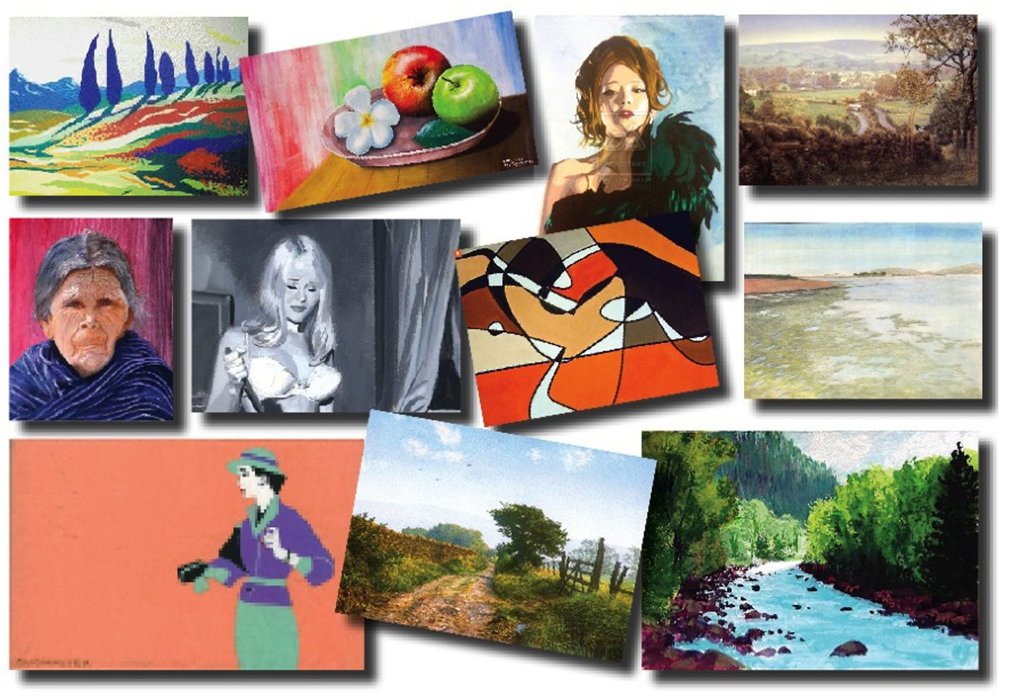……………. by David Halliwell
The use of gouache can be traced back 800 years, used originally to illuminate manuscripts.
It is basically an opaque watercolour. You can use it with pale washes like watercolour or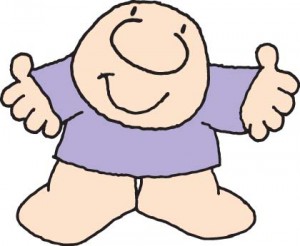 quite thick like oils. It dries very quickly, an advantage over oils, but can be rewetted and remains active, unlike acrylic. With gouache (pronounced gwash) it is possible to overpaint already dry paint with lighter or darker colours without activating the colour underneath, although this has to be done carefully. Light shades generally dry darker and dark shades dry lighter (you use a lot of white with gouache). This can be confusing but when the painting is varnished the original shades return. Gouache needs to be varnished or protected behind glass as it will be damaged if in contact with water.
quite thick like oils. It dries very quickly, an advantage over oils, but can be rewetted and remains active, unlike acrylic. With gouache (pronounced gwash) it is possible to overpaint already dry paint with lighter or darker colours without activating the colour underneath, although this has to be done carefully. Light shades generally dry darker and dark shades dry lighter (you use a lot of white with gouache). This can be confusing but when the painting is varnished the original shades return. Gouache needs to be varnished or protected behind glass as it will be damaged if in contact with water.
I have been painting with gouache for years, but I am surprised that very few others paint with it. Gouache was the preferred medium for commercial artists, hence Designers Gouache from Winsor & Newton, and as I was a graphic designer I got to use it very early on. It’s all been replaced by computers now of course. I have used watercolours, acrylics and oils but find gouache suits what I want to do, and that is paint fine detail. I couldn’t do it with oils or acrylics although many others have success but I do enjoy watercolours as they are more spontaneous and a watercolour painting is usually completed in one sitting whereas a gouache needs several weeks. I paint on either stretched canvas or canvas surfaced artboards, both produced primarily for oil paints, and usually work on local areas before moving on to the next section.
So, that’s a potted history of gouache and how I was introduced to it, now for some Q & A’s.
Let me say that these are entirely my own observations and are in no way sacrosanct. There are no rules in art, apart from the rule that if there are rules then rules can be broken.
If you know what I mean.
Which paint to use
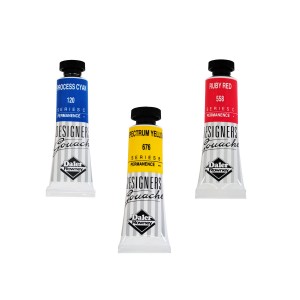 There are basically two kinds of gouache, cheap stuff and expensive stuff. The cheaper paint will fade more quickly that the expensive variety but we really need not worry about this unless the painting is in full sunlight. I use the cheap paint and the expensive, and use them together. Hobbycraft from time to time do an offer whereby you can buy a packet of 20 tubes for only £9.99, I have seen the same offer in Lidl, both under the Reeves brand. When you consider you could spend up to £5 for a single tube of Winsor & Newton you can see the difference. The reeves brand is perfectly adequate, but if you were a professional then the Winsor & Newton brand would probably be the brand of choice.
There are basically two kinds of gouache, cheap stuff and expensive stuff. The cheaper paint will fade more quickly that the expensive variety but we really need not worry about this unless the painting is in full sunlight. I use the cheap paint and the expensive, and use them together. Hobbycraft from time to time do an offer whereby you can buy a packet of 20 tubes for only £9.99, I have seen the same offer in Lidl, both under the Reeves brand. When you consider you could spend up to £5 for a single tube of Winsor & Newton you can see the difference. The reeves brand is perfectly adequate, but if you were a professional then the Winsor & Newton brand would probably be the brand of choice.
Brushes
I use watercolour brushes, mainly No.’s 2, 4 and 8. I also have at least 2 rigger brushes 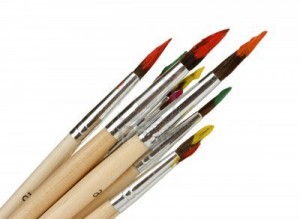 which are used in the final stages of detailing. You don’t need to buy top of the range sable brushes, in fact I would say you are wasting money if you do as the brushes tend to wear out quicker in gouache than they do in watercolour. Not sure why, but it could be because of the rough surface I paint on, which we will cover later. Also in my paint box is a 1” paintbrush, normally used for window frames, and a basting brush from the kitchen drawer. Remember, there are no rules. I find that the synthetic ones have a nice amount of ‘spring’ in them and this to me is essential. I also have flat brushes ranging from 1/8” to ½” and these are very handy for painting bricks, amongst other uses.
which are used in the final stages of detailing. You don’t need to buy top of the range sable brushes, in fact I would say you are wasting money if you do as the brushes tend to wear out quicker in gouache than they do in watercolour. Not sure why, but it could be because of the rough surface I paint on, which we will cover later. Also in my paint box is a 1” paintbrush, normally used for window frames, and a basting brush from the kitchen drawer. Remember, there are no rules. I find that the synthetic ones have a nice amount of ‘spring’ in them and this to me is essential. I also have flat brushes ranging from 1/8” to ½” and these are very handy for painting bricks, amongst other uses.
What do I paint on?
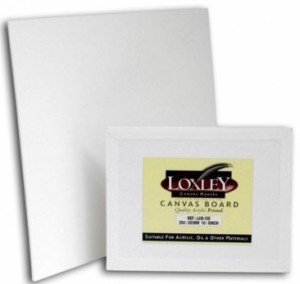 Basically, anything. As long as you apply a good covering of paint, or undercoat, to begin with so that the gouache will grip or ‘key’. For myself I prefer stretched canvas or canvas board, both of which are primarily made for oil paints and because of the textured surface this is maybe why my brushes wear out quicker. You can also paint on water colour paper, and because generally you use less water the paper is less likely to cockle. If you start to paint on stretched canvas or canvas board and find the paint won’t stick to the surface it will be because you are using too much water, like doing a
Basically, anything. As long as you apply a good covering of paint, or undercoat, to begin with so that the gouache will grip or ‘key’. For myself I prefer stretched canvas or canvas board, both of which are primarily made for oil paints and because of the textured surface this is maybe why my brushes wear out quicker. You can also paint on water colour paper, and because generally you use less water the paper is less likely to cockle. If you start to paint on stretched canvas or canvas board and find the paint won’t stick to the surface it will be because you are using too much water, like doing a
watercolour, because the surface has a slightly oily finish and that’s what happens. The answer is simply use less water. Keep your paint nice and creamy, a bit like yoghurt, and you’ll have no problem. I very rarely use a colour straight from the tube, if painting something green I will use at least two shades of green, possibly with yellow ochre or raw sienna as this adds opacity to the colour.
Which medium to use
Well, it all depends on which you are happiest with.
The advantage of gouache over oils is that it dries almost straight away. Both mediums  allow the paint to be applied thickly, but there is a risk of it cracking with gouache if too thick. However, I believe there is something you can add to your paint now that overcomes this problem, not sure what as I don’t paint that thickly but a bit of research will find the answer. (editor….. the addition of Gum Arabic is said to reduce cracking) When you compare gouache with watercolour there are many similarities. Both are water based, both can be used as thin transparent washes. Watercolour paint is more luminous in colour than gouache, as gouache has got white pigment added. The best gouache is not manufactured by adding white but by using an extremely high level of pigmentation. This leaves the artist free to add white themselves or colour mix as they wish, cheaper gouache colours are made opaque by the addition of white.
allow the paint to be applied thickly, but there is a risk of it cracking with gouache if too thick. However, I believe there is something you can add to your paint now that overcomes this problem, not sure what as I don’t paint that thickly but a bit of research will find the answer. (editor….. the addition of Gum Arabic is said to reduce cracking) When you compare gouache with watercolour there are many similarities. Both are water based, both can be used as thin transparent washes. Watercolour paint is more luminous in colour than gouache, as gouache has got white pigment added. The best gouache is not manufactured by adding white but by using an extremely high level of pigmentation. This leaves the artist free to add white themselves or colour mix as they wish, cheaper gouache colours are made opaque by the addition of white.
The advantage of gouache over acrylics is that gouache can be rewetted when it has dried, and also your pallette colours are not wasted, next time you paint you can re-activate them. This is not to say in any way that gouache is better than acrylics, acrylics has it’s own advantage in that it is waterproof when dry. And others will find other advantages.
There is nothing to stop you mixing any, or all of these media in one work of art.
Techniques
All art is down to technique, or, the way you individually paint. Some things you can do with gouache are worth mentioning. The ability to paint over something you are not happy with, indeed you can remove the complete picture and start again. Because the paint is thick and opaque you can apply it with things like sponges when painting trees, pallette knives, edges of cardboard, scrumpled kitchen roll, in fact you can try anything and see what effect you can achieve. Mainly I use brushes, sponges and kitchen roll and a ruler for straight lines. (Remember, no rules, apart from rulers!)
Examples of paintings using Gouache
I have done a quick search on Google and these are just some of the different styles and techniques:-
